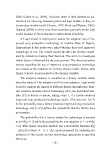Page 674 - 2015-37
P. 674
2008; Kassie et al., 2009). However, there is little theoretical jus-
tiication for choosing between probit and logit models as they of-
ten produce similar result (Greene, 1997; Stock and Watson, 2003).
Gujarati (2004) is of the view that researchers generally prefer logit
model because of its comparative mathematical simplicity.
A Logit model is employed to assess the adoption rate of im-
proved crop production Technology in Katsina State of Nigeria.
Respondents in this study were asked whether they used improved
technology or not. The binary model speciies the factors consid-
ered by farmers in making their decision. The aim is to investigate
which factors inluenced the decision process. The observed yes/no
answer regarding the use of improved crop production technology
are viewed as the outcome of a binary choice model. Hence, each
farmer’s choice is represented by the dummy variable:
The adoption decision is modeled as a binary variable which
takes the value of 1 for adopters and 0 for non-adopters. Logit model
is used to analyse the impact of different factors that inluence farm-
ers› adoption decision of new technology. Here, the dependent vari-
able (Yi) is binary in nature, taking value 1, if a farmer employs
improved crop production technology and 0, if he does not. Let Pi
be the probability that a farmer practices improved crop production
technology and (1−Pi) deines the probability that the farmer does
not practice.
The probability that a farmer adopts the technology is denoted
as p = P[yi = 1] while the probability for non-adopters is 1 - p =P[yi
= 0]. This binary adoption variable has a probability function f(y)
= py(-p)1-y where y = 0, 1. The model proposed for analysing the
inluence of the factors on new technology agriculture is speciied
below as:
-9-

